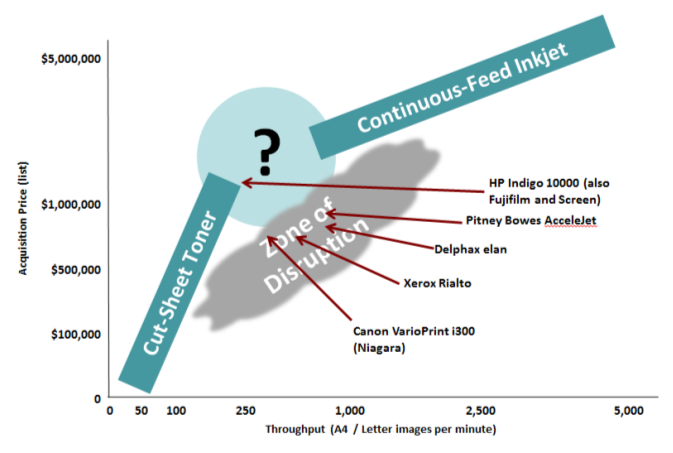
Pitney Bowes has just announced a new product called the AcceleJet printing and finishing system. AcceleJet is a narrow-web, continuous-feed to cut-sheet, inkjet printing system capable of speeds up to 246 feet per minute (75 meters per minute) and throughput exceeding 500 letter-sized images per minute. Intended for a monthly volume range of four to 10 million letter/A4 images per month, Pitney Bowes is targeting the AcceleJet at market segments such as service bureaus, direct mailers, and in-house operations in non-profits, financial services, insurance, healthcare, utilities, and government. Pitney Bowes estimates that an AcceleJet system—including the controller, print engine, and finishing capable of dynamic perforation, sheeting, and stacking—will have an average system selling price of $850,000.
AcceleJet fits well in the gap between existing cut-sheet electrophotographic and continuous-feed inkjet color products. This gap, known as "the Zone of Disruption," is an area where high-speed and cost-effective products are challenging existing offerings. To be viable in this zone requires an acquisition price less than $1 million, high levels of productivity, and a running cost model below that of toner-based products. Pitney Bowes' new AcceleJet printing and finishing system meets all of these requirements and joins a small number of other offerings that are available today (or will be soon). Current inkjet products in the Zone include Canon Océ’s VarioPrint i300, Delphax’s elan 250/500, Xerox’s Rialto 900, and now Pitney Bowes’ AcceleJet. AcceleJet is most similar in concept to Xerox’s Rialto, but from a price point and productivity perspective will compete with the B3-format VarioPrint i300 and the B2-format elan 250/500. Existing B2-format digital products like HP Indigo’s 10000 and Fujifilm’s J Press 720S come in at a higher price point above the Zone and are both targeted at general commercial and higher quality publication markets. The primary focus of products in the Zone today is in applications like bills & statements, direct mail, and educational books.
 AcceleJet is an important new market addition in the Zone of Disruption that will bring the benefits of high-speed color inkjet to a new class of users. In a market place where color is king, personalization is the norm, and manufacturing is not only lean, but also just-in-time, AcceleJet has the potential to help producers of transactional documents and direct mail to address document complexity, compliance risks, and reply rates in a highly automated fashion.
AcceleJet is an important new market addition in the Zone of Disruption that will bring the benefits of high-speed color inkjet to a new class of users. In a market place where color is king, personalization is the norm, and manufacturing is not only lean, but also just-in-time, AcceleJet has the potential to help producers of transactional documents and direct mail to address document complexity, compliance risks, and reply rates in a highly automated fashion.
Continuous-feed inkjet products with web widths of 20 inches or wider have had remarkable success in the past few years but not all users are able to afford a million-dollar plus price tag, particularly if they need to build in a second unit as back-up or disaster recovery as part of their capabilities. Getting underneath a million dollar capital acquisition level opens up new opportunities for these users. Product footprint is another factor. Products in the Zone will be more attractive if they fit into size constrained environments more easily than the 20-inch continuous-feed inkjet offerings.
With AcceleJet, Pitney Bowes now has an inkjet printing system portfolio that stretches in format from one-up to four-up to meet the application and volume needs of a broad range of users. Pitney Bowes' expertise in the print and mail market is another important aspect of the announcement. None of the other continuous-feed inkjet printing system vendors brings the same level of accumulated knowledge about mailstream workflow as Pitney Bowes. Together with Pitney Bowes offerings such as Print+ Messenger and Epic, this assembled package should be very attractive to users in print and mail environments who want to gain the advantages of a white paper factory at a scale that fits their needs.
InfoTrends has just completed a white paper on AcceleJet that Pitney Bowes will be distributing at GRAPH EXPO 15. For a look at GRAPH EXPO, see my blog entitled "GRAPH EXPO Expectations."
- Companies:
- Pitney Bowes












